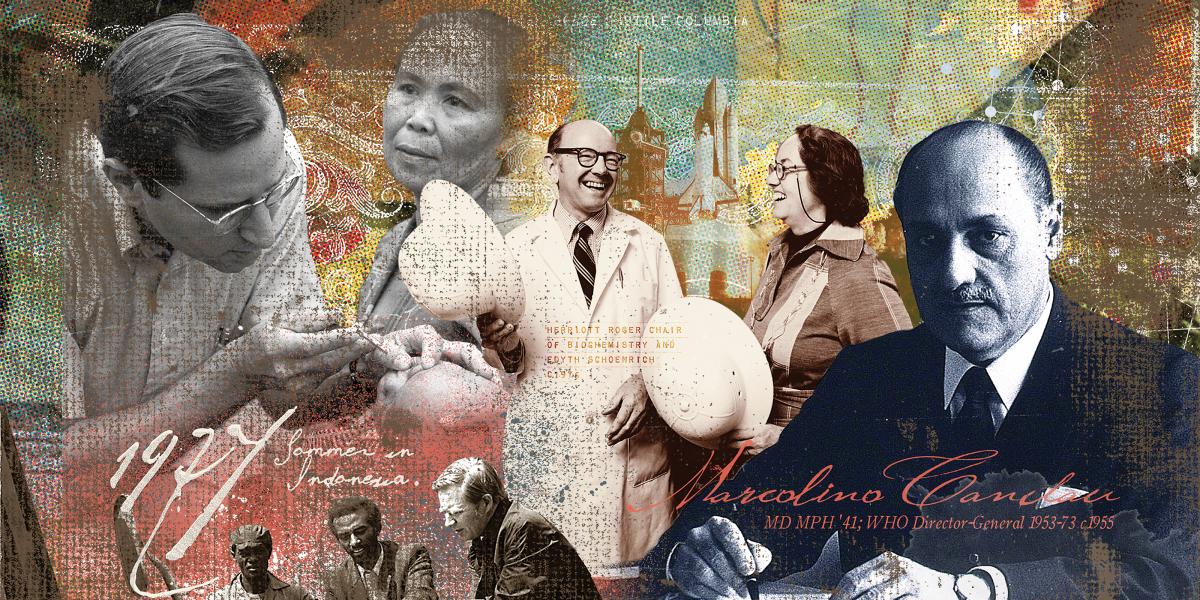Visions of Global Health
Turning Points | Four defining moments in the history of the Bloomberg School
In 1948, Fred Soper, DrPH ’25, had predicted that 90 percent of malaria cases worldwide could be eradicated within 10 years, at a cost of $280 million. Yet after the WHO malaria eradication program was launched in 1955, human, political, biological and environmental factors wreaked havoc with the best-laid plans of technical advisers. Monsoons in Asia and sand in Africa rendered equipment useless, and mosquitoes’ growing resistance to insecticide everywhere mocked the dream of disease eradication.
After the World Health Assembly approved a global smallpox eradication program in 1966 by a narrow two-vote margin, Marcolino G. Candau, MPH ’41, director-general of WHO, feared the program would draw resources and personnel away from the flagging anti-malaria program. Candau tapped D.A. Henderson, MPH ’60, to head smallpox eradication because he wanted an American to take responsibility in the event of failure. Given Candau’s lack of commitment to smallpox eradication, Henderson was initially reluctant to accept because he viewed WHO as “a dysfunctional bureaucracy that was incapable of managing a global disease eradication campaign.” In 1969, WHO formally abandoned the global malaria eradication campaign first proposed by Soper and advanced by a generation of JHSPH parasitologists.
Building on the foundation of the polio vaccine and pregnancy and prematurity research of the 1950s, the epidemiological studies of developmental disabilities in the 1960s and the research on diarrheal diseases, pediatric malnutrition, family planning and primary health care of the 1970s, JHSPH researchers would target each of these factors one by one, and then in combination, carefully amassing the scientific basis for what would become known in the 1980s as the global child survival revolution. Nathaniel F. Pierce, R. Bradley Sack, ScD ’68, Charles Carpenter and their colleagues, drawing from their work with the Johns Hopkins Center for Medical Research and Training cholera program in Calcutta and in other countries, helped to establish oral rehydration therapy as the standard pediatric treatment for cholera and other diarrheal illnesses. They also worked to convince U.S. physicians to adopt ORT in place of traditional intravenous therapy requiring hospitalization.
Henry Mosley, MPH ’65, who had chaired Population Dynamics from 1971 to 1977, was at the confluence of the family planning, diarrheal disease and nutrition streams of the child survival river. He had returned to Dhaka to lead the reorganization of the International Centre for Diarrhoeal Disease Research, Bangladesh.
When UNICEF Director Jim Grant, son of international health giant John Black Grant, DrPH ’21, launched the historic child survival initiative in 1980, he asked Mosley to advise a range of agencies, including the Population Council and Ford Foundation, to develop the framework for child survival programs in Kenya and Indonesia. In 1984, Mosley and his former student Lincoln Chen, MPH ’73, published Child Survival: Strategies for Research, which became a master plan for child survival research.
Henderson recruited Mosley back to JHSPH in 1985 as chair of Population Dynamics. Meanwhile, Mosley’s former Epidemic Intelligence Service colleague in Bangladesh, Alfred Sommer, MHS ’73, had returned to the Johns Hopkins medical faculty in Ophthalmology with a joint appointment in Epidemiology. In 1983, Sommer published the first articles on his landmark epidemiological field trials on the causes and consequences of vitamin A deficiency. Sommer’s research, after steep initial resistance, would lead WHO and UNICEF to adopt large-scale distribution of high-dose oral vitamin A supplementation in developing countries as a cost-effective method to prevent blindness and cut child mortality rates by 34 percent. UNICEF, WHO and other international agencies and NGOs combined these methods in mass campaigns throughout the developing world to halve the global mortality rate among children under age 5 between 1980 and 2010.
-
1980
Epidemiology chair Leon Gordis establishes a clinical epidemiology training program.
-
1981
For the first time, women comprise a majority of the School's graduates.
-
1983
JHSPH leads the university in appointing the first female department chair: Karen Davis in HPM.
-
1984
Johns Hopkins joins the Multi-Site AIDS Cohort Study.
-
1984
Robert Black, an expert on micronutrients and maternal/infant mortality, becomes chair of International Health.
-
1985
Mary Lou Clements, a pioneer vaccine researcher, founds the Center for Immunization Research.
-
1986
Biostatisticians Kung-Yee Liang and Scott Zeger publish the highly cited General estimating Equation for determining the effect of variables on disease transmission.
-
1986
With Tom Beauchamp, Ruth Faden writes A History and Theory of Informed Consent, a founding bioethics text.
ONWARD: THE BLOOMBERG YEARS
By the mid-1980s one of the School’s greatest turning points was still more than a decade in the future: The philanthropic support of Michael R. Bloomberg. In 2001, the School would be renamed in honor of Bloomberg’s remarkable commitment to the School and the entire Johns Hopkins University. Bloomberg’s philanthropy led to major initiatives at the School in malaria, road traffic safety, tobacco control, gun violence, global health and other areas. While serving as New York City mayor from 2002 to 2013, Bloomberg consulted with the School on key health policy issues and enacted sweeping public health measures, including the first indoor smoking ban in bars and restaurants in a major U.S. city. Bloomberg’s visionary support has helped School faculty, students and alumni meet the public health challenges of the 21st century.
